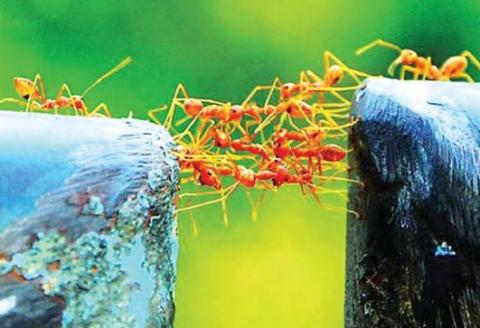Army Ants Build Moveable Bridges With their Own Bodies
But what happens when the ants meet the tipping point – when more of their number are required to make the bridge than are available to forage for food?
Last month, moisture from Hurricane Joaquin flooded much of SC, and we were reminded about the ant’s versatility when we saw video of them traveling in “rafts” above the surface of the floodwaters.
When army ants need to cross a large gap, they simply build a bridge – with their own bodies. They facilitate maximum speed across the treacherous rainforest floors of Central and South America.
In the new study – published Monday in the journal Proceedings of the National Academy of Science – the researchers found that besides cooperating with each other, the ants also appeared to weigh the benefits and costs of making a longer bridge.
Chris Reid, the lead researcher of this study said that the ants are the best example of swarm intelligence, where individual-level interactions are causing group behavior.
“Our work has implications for other self-assembling systems, such as reconfigurable materials and autonomous robotic swarms”, says Reid.
Researchers at the Princeton University as well as the New Jersey Institute of Technology have said that army ants can make living bridges without making any mistakes.
He added that even if they could create better shortcuts in many instances, the ants would halt their bridges before they achieve the shortest possible route. Why?
An algorithm skilfully underpins the army ants’ architectural endeavors.
The team of researchers – from the Max Planck Institute for Ornithology (Konstanz, Germany), University of Konstanz, and the United States’s New Jersey Institute of Technology, Princeton University and George Washington University – found the bridges can assemble and disassemble in seconds.
The army ants were positioned on the side of the bridge that was furthest from the crook in the gap; but they stopped building the bridge at one point.
Army ants form collective assemblages out of their bodies to perform a variety of functions that benefit the entire colony. They do work with quite a cost to benefit ratio.
“This is an elegant, quantitative study of the wonderful adaptive abilities of army ants”, commented Prof Nigel Franks, who runs an ant research lab at the University of Bristol.
The ants act together as one unit and all ants are aware of their immediate circumstances. As expected, the ants used their bodies one-by-one to build the living bridge.
Reid also looks to the ants for such insights.
Couzin believes that understanding this species’ trick could change the way we think of self configuring structures, both in nature and those made by man. And now researchers have checked out their bridge building to pick up any clues for future robotics creations.








